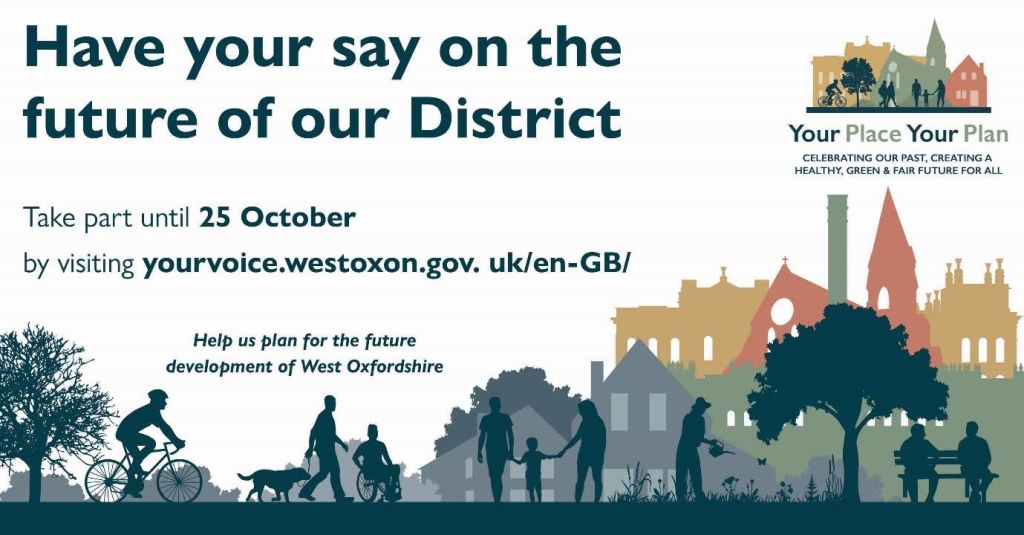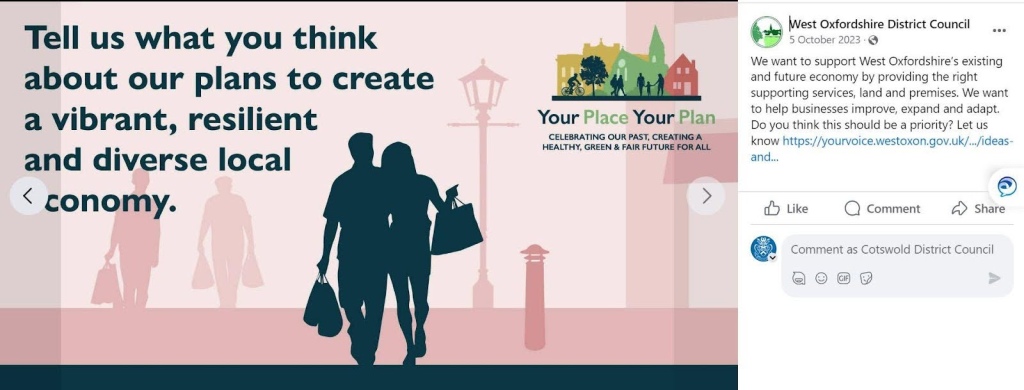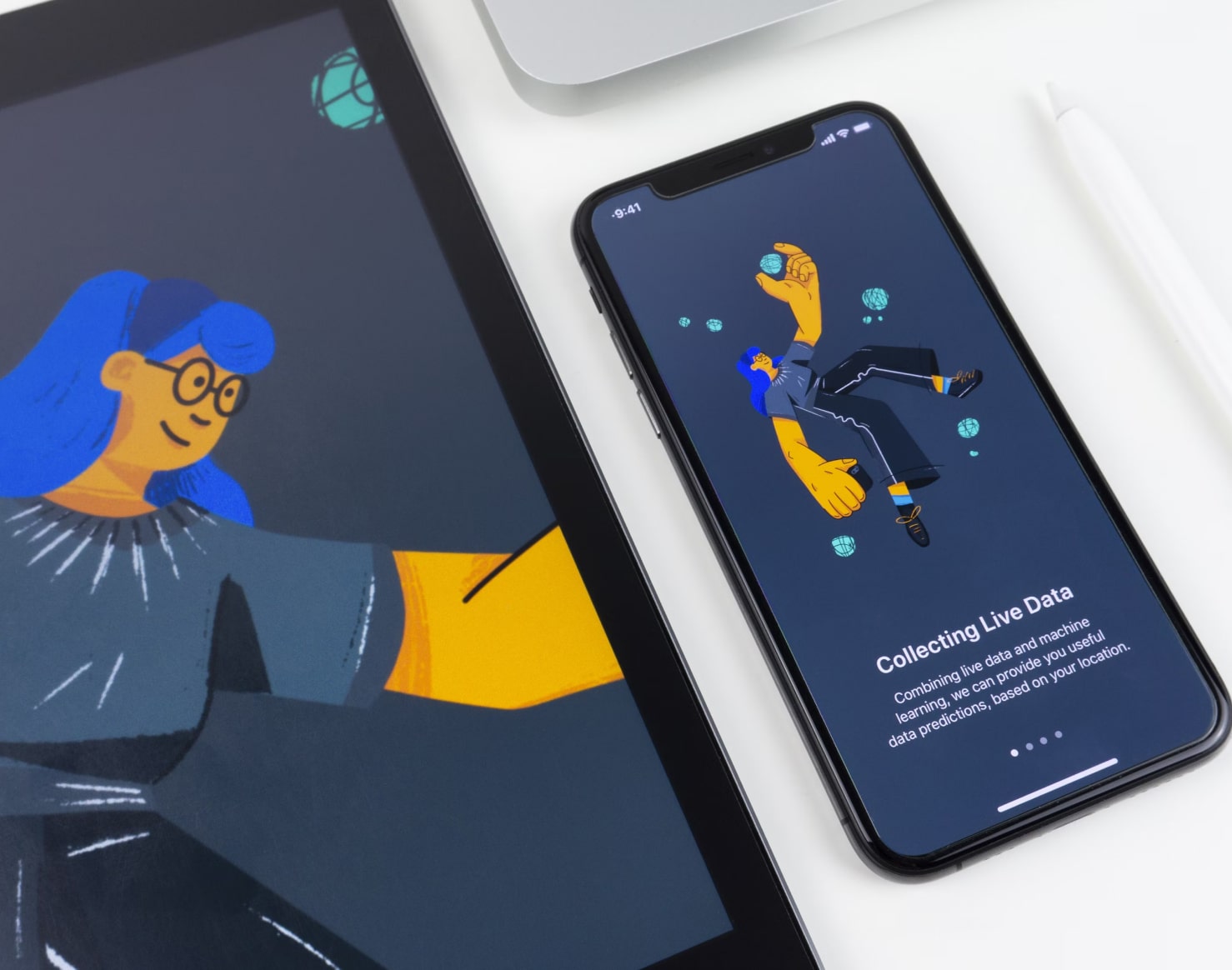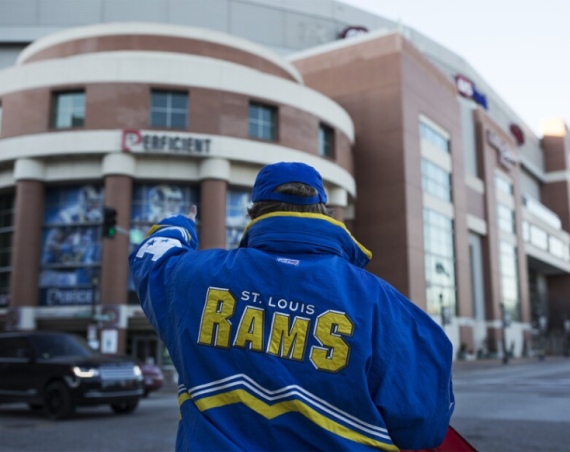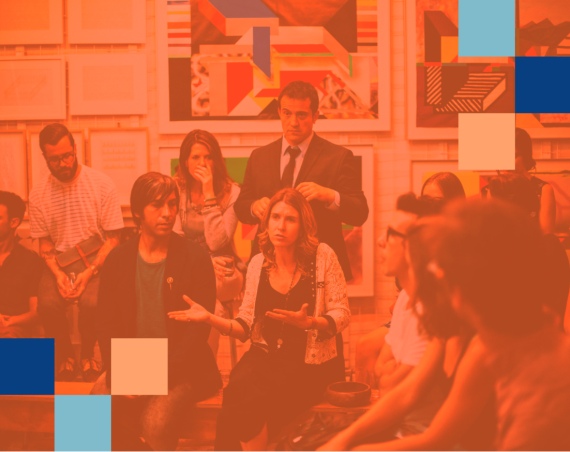Engaging the public on the complex topic of local planning poses significant challenges. To explore how a well-crafted communications strategy can help overcome these hurdles, we sat down with Mark Prichard, the Head of Communications for West Oxfordshire, Cotswold, and Forest of Dean Councils (UK) to talk about their recent success. This interview equips local council communications officers and planners with the tools to navigate these challenges and foster productive community engagement.
Before we dig deeper into certain aspects of your communications strategy for a given local plan project, could you maybe highlight the main steps of such a comms strategy?
Mark: Early engagement with the strategic planning team is essential to understanding their priorities, what they see as the communications risks (are we announcing a large development, for example), and their expectations around engagement levels.
As a team, we follow the OASIS model. Essentially, it’s a best-practice framework for good communications based on setting clear objectives, understanding your audience and measuring results.
OASIS makes you think about what you’re trying to achieve. Before you start anything, you think about what will have changed once the campaign has been delivered. What does success look like? How does that contribute to organisational objectives? How can we measure that?
For the purposes of a local plan, it’s important that early on you ask those questions and agree SMART objectives. These are the kinds of conversations we had with the West Oxfordshire and Cotswold strategic planning teams that helped shape the whole campaign and consultation. This consistent engagement with the team also helps to embed communications as a critical function to the success of a consultation.
What timeframe do you usually work with when you launch a communications plan?
Mark: I would really recommend you start early— at least six to eight weeks before the launch of any consultation—so that you have the time to think through objectives, develop materials and consider branding properly. Having said that, I would advocate keeping the comms team as part of the project team all the way through so they can provide advice on how to shape the processes and communications as you move forward.
Who are the main stakeholders you’d want to engage with in a local plan consultation and how do you make sure no one is left behind?
Mark: Ultimately, we would like everyone in the district to give a view but that isn’t realistic. Of course, we have our usual suspects – the relatively small number of people who have previously commented on local plans and are interested in planning. You then also have the statutory consultees, such as town and parish councils. These people and groups will engage but it misses a huge proportion of the population the local plan impacts.
Since we’ve been working more closely with our forward planning team, we have been working to identify and connect with new audiences. This includes targeted work with younger people and young families, amongst others. The local plan will directly impact their future and we wanted to help them see why engaging with the process was important for them and what they could get out of taking part in the consultation.
Our CitizenLab engagement platform helps us measure new visitors, so we can monitor the demographics of people responding and tweak the campaign as we progress to make sure our comms land in the right way. We don’t struggle to reach parish and town councils or statutory consultees. We also don’t struggle to reach the loud voices. It’s the rest of the population that is a challenge and carefully segmenting and targeting different audiences can help reach them.
Another key element of a communications strategy is branding and language. What’s their place in planning consultations? How important is it, how do you adapt it to your residents?
Mark: In both the West Oxfordshire and Cotswold planning consultations, it was our view that branding is very important. Developing a local plan spans multiple years and goes through many stages. Previously, there was no coherence between various local planning consultations. People could not see that they were all part of the same process so the branding is important to tie it all together. Each time we start a new consultation, they see the same branding and they start to associate that with it all being one local plan. We also wanted to use the branding to localise it and make it meaningful to people.
In the design, we tried to pick elements that people would recognise and feel an affinity towards, something that would attract them to the local plan consultations and help us get more traction. The idea is that the local plan doesn’t belong to the council, it isn’t about producing a document because we legally have to. It is for the residents, and they need to feel like they are part of the decision-making process. This is the future of their area. We’re writing the plan as a council, but you’ve got a chance to share your input.
How does brand harmonisation build awareness around the local plan? More generally, how do you build awareness around such a technical issue such as planning, which does, however, affect the future of the areas people live in?
Mark: That’s a very good question. For me, it’s making sure the communications relate to the people we are targeting and is understandable. It also comes back to the fact that the local plan is more than just one consultation. It is something you can build over time. For the Cotswold Local Plan, we have had 2 years of using the brand and it’s been used consistently across digital channels. A lot of marketing theory says you won’t engage with something until you’ve seen it 6, 7, or 8 times. We want people to gradually build that affinity and associate the branding with the local plan.
We’ve also tested many different types of content, including animations, videos, and case studies, to see what engages people and encourages them to take action.
The language that we adopted from the onset aimed to be inclusive such as using the words “you”, “yours’, and “your” so that residents can start feeling it is theirs to contribute to and not just another council document. The digital platforms we use also enable us to apply all of that branding to consultation documents that we have not been able to do in the past.
(Interview continues below the following images)
Examples showing Cotswold’s Local Plan consultation branding
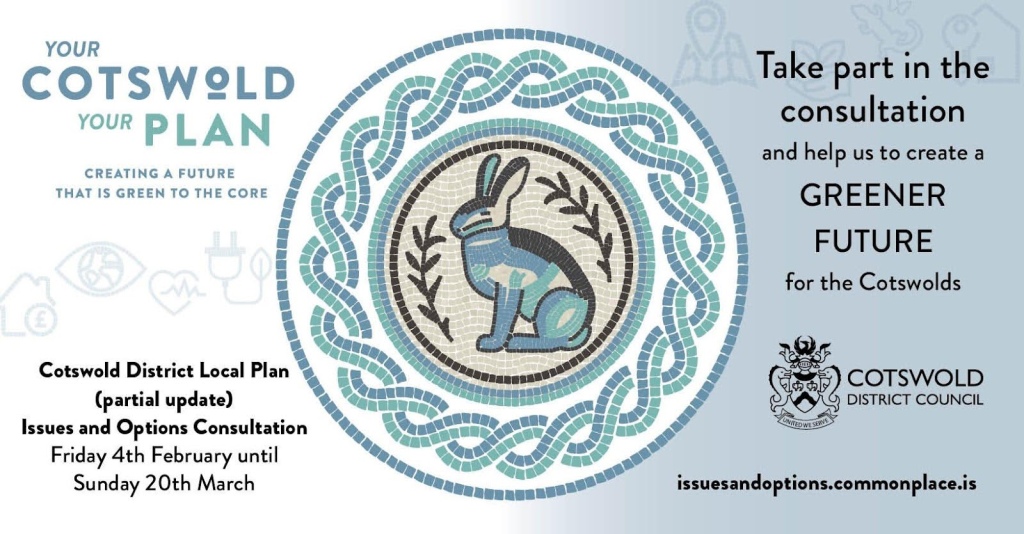
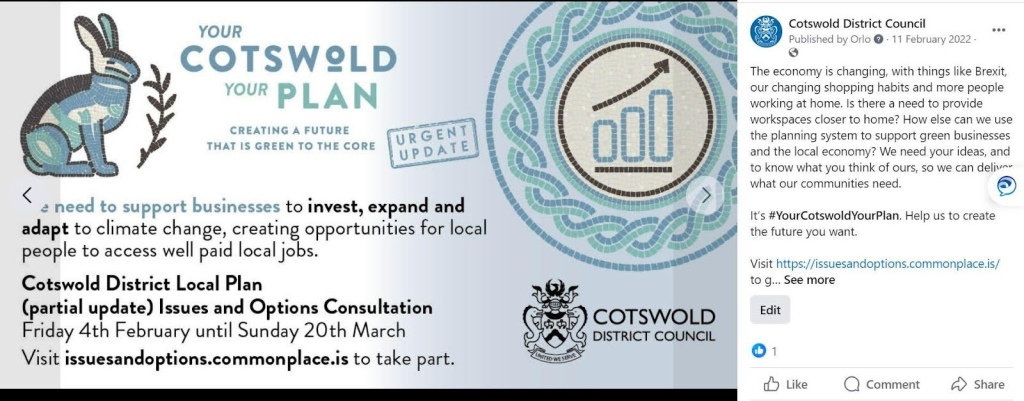
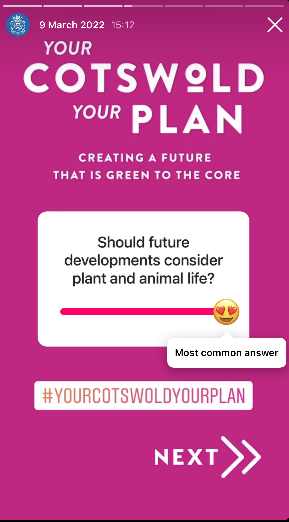
You can find examples from West Oxfordshire’s Local Plan consultation branding at the bottom of the interview.
Could you share an example of how you can make language more accessible?
Mark: During earlier conversations today, one planner from Gloucester City Council mentioned that it’s all about explaining some of the terminology in a simple way that people can understand. They gave the example that when talking about housing, they found that young people immediately assumed it had to do with homelessness rather than new housing for themselves. Climate change is another good example. What do we actually mean by it? It is a broad term. It’s all about moving away from buzzwords and actually helping people understand what we are talking about in practice. Plain English is key, as is testing messaging and listening to feedback from audiences.
To make information more accessible, we have also tested condensing the lengthy details of local plan documents into digestible formats. For example, we created a “local plan in a nutshell,” which distils a several hundred-page document into a concise overview. This approach not only caters to those who prefer quick insights but also accommodates the increasing number of people accessing information on mobile devices. By making our communications more effective and far-reaching, we ensure that everyone can understand and engage with the material in a meaningful way.
Again, our digital engagement platform came in handy. CitizenLab’s integration with Konveio helps us incorporate glossaries into documents so that residents can quickly decipher more technical vocabulary where we have to include it
How do you tailor your communication and engagement strategies to engage specific demographic groups effectively?
Mark: In our efforts to make our consultations more accessible and engaging for specific demographic groups, particularly young people, we have adapted our strategies to meet their preferences and behaviours. For example, during a project in Cotswold, we noticed a significant number of young people were driven to our consultation platform via social media posts, however, once they arrived, they found the planning documents overwhelming and disengaged.
To address this, we created a dedicated area on the platform specifically for them. This section featured simpler engagement tools, like multiple-choice questions, designed to be less intimidating. By doing so, we aimed to maintain their interest and encourage meaningful participation. This adjustment not only made the information more approachable but also demonstrated our commitment to inclusivity in the consultation process.
Once a local plan has been decided or implemented, what role do communications and marketing play in communicating the outcomes to the community, and why is it important to keep the public informed even after the plan is in place?
Mark: Ongoing communications and marketing play a vital role in ensuring the community sees the impact of their feedback and feels listened to. We provide updates and link the new information back to previous engagement to help tell the story. This helps keep the narrative alive and ensures continuity in communication throughout the process
This dialogue is vital because it reinforces why community input is essential and encourages continued engagement. Why else would they engage again in the future? By providing these updates, we remind the community that their contributions have shaped the outcomes and reinforced the importance of their continued participation.
Looking ahead, what are some improvements you feel you can make or something that you might do differently for your next project?
Mark: We can still do a lot more to make forward planning more accessible to residents. It is a very technical process with lots of detail that puts off many people for a wide range of reasons. Given the importance of local plans to communities, I feel we have a duty to continue to improve engagement. The process needs to evolve to meet the needs of residents as much as the need to produce a formal local plan document.
We also want to continue exploring CitizenLab’s engagement platform’s capability to help us better engage residents and make the consultation response process more interesting and accessible for people who haven’t participated in such consultations before. Our planning teams are also exploring using AI technology within the platform to help speed up identifying and summarising key discussion points, such as the top five topics.
Want more communications tips?
Download our guide “Building a communications plan for engagement projects” now! Digital engagement and consultation will become an even more crucial part of the planning process. This guide, co-written with our partner Koru, shows how CitizenLab can support public engagement in every stage of plan-making. Download the free guide
If you’re ready to chat about how the CitizenLab platform can help your council reach residents where they are and encourage them to participate in your (local plan) consultations, you can schedule a personal chat.
